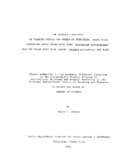Mostrar el registro sencillo del ítem
An economic analysis of farming coffee and trees at Turrialba, Costa Rica: comparing small farms with poro (Erythrina poeppigiana) only to those with both laurel (Cordia alliodora) and poro
| dc.contributor.advisor | McKenzie, Thomas | es_Es |
| dc.contributor.author | Barker, David J. | |
| dc.date.accessioned | 2014-10-20T04:03:06Z | |
| dc.date.available | 2014-10-20T04:03:06Z | |
| dc.date.issued | 1991 | es_ES |
| dc.identifier | 340327 | es_ES |
| dc.identifier.uri | https://repositorio.catie.ac.cr/handle/11554/4429 | |
| dc.description | Tesis (M. Sc) -- CATIE, Turrialba (Costa Rica), 1991 | es_ES |
| dc.description.abstract | This thesis compares the economics of two agroforestry systeMON: growing coffee in plantations (Coffea arabica var. caturra), using either poro (Erythrina poeppigiana) alone or poro with laurel (Cordia alliodora) for shade trees mixed with the coffee bushes. The hypotheses were that: 1) The net present value (NPV) of the coffee/laurel/poro (laurel) is better than the NPV of the coffee/poro, (poro), 2) There will be more firewood accruing from the laurel combination, 3) There will be lower labour requirements for pruning in the laurel combination and 4) Market risk for coffee is better handled by the laurel farmer. An initial survey of 20 small farMON in the Turrialba area of Costa Rica was made to describe typical systeMON in the zone and to derive estimates of farm management costs and coffee yields. A sub-sample of two groups of four farMON each was then taken: coffee farMON with poro alone and coffee farMON with poro and laurel. On each of these eight farMON, a questionnaire was given and measurements taken to determine yields, product prices and costs. Results indicated that the Laurel FarMON had a higher net present value than the Poro FarMON over 25 years, due principally to higher coffee yields. This larger NPV differences, however, may have been affected by the location of the farMON. The impact of income from trees was significant only during periods of low coffee prices. Poro farmers had higher per hectare labour costs than laurel farmers. Increased firewood form the Laurel FarMON was trivial. Both types of farMON showed management strategies for handling market risk, but the poro farmers had higher costs using these strategies. | es_ES |
| dc.language.iso | es | es_ES |
| dc.publisher | Centro Agronómico Tropical de Investigación y Enseñanza (CATIE), Turrialba (Costa Rica) | es_ES |
| dc.subject | COSTA RICA | |
| dc.subject | COFFEA ARABICA | |
| dc.subject | CORDIA ALLIODORA | |
| dc.subject | ERYTHRINA POEPPIGIANA | |
| dc.subject | CULTIVO INTERCALADO | |
| dc.subject | AGROFORESTERIA | |
| dc.subject | PLANTAS DE SOMBRA | |
| dc.subject | EXPLOTACION EN PEQUENA ESCALA | |
| dc.subject | RENDIMIENTO | |
| dc.subject | ANALISIS DE COSTOS Y BENEFICIOS | |
| dc.title | An economic analysis of farming coffee and trees at Turrialba, Costa Rica: comparing small farms with poro (Erythrina poeppigiana) only to those with both laurel (Cordia alliodora) and poro | es_ES |
| dc.type | Tesis de maestría | es_ES |
| dcterms.rights | acceso abierto | |
| dc.identifier.publication | Turrialba (Costa Rica) | es_ES |
Ficheros en el ítem
Este ítem aparece en la(s) siguiente(s) colección(ones)
-
Tesis [1371]


